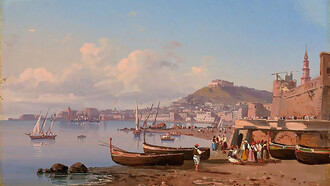One of the most beautiful and historical places in Samarkand is Shakhi-Zinda. In fact, Shakhi-Zinda complex is considered as one of the most detailed architectural constructions in Asia. The Shakhi-Zinda ensemble is not only a historical-architectural monument, but also a complex with the mausoleums of famous scholars, saints, queens, and military commanders. Despite the fact that each mausoleum here is covered with unique decorations, they all form a single composition, a complete architectural work.
Another valuable aspect of Shakhi-Zinda is that almost three thousand years of Samarkand's history is embodied there. The meaning of the word Shakhi-Zinda is "living king". According to Muslim historians, Shakhi-Zinda is a title given to Qusam ibn Abbas, the cousin of the Prophet Muhammad. According to Muslim historians, Qusam ibn Abbas came to Samarkand with the Arab army in the 8th century and was engaged in promoting Islam in the region. Some people who were against Ibn Abbas tried to kill him. A tomb was built for him in front of the cave where Qusam ibn Abbas disappeared, and a mausoleum was built over the tomb in the 11th century.
In addition to the mausoleum, a luxurious shrine, a mosque also functioned here. The Mongol invasion of Samarkand in 1220 severely damaged Shakhi-Zinda's mausoleum. The Mongols destroyed many buildings and tombs here. However, they were also afraid to touch the grave of Qusam ibn Abbas. However, this tomb had become a ruin. By the beginning of the 14th century, with the efforts of Samarkand religious people and leaders, a mausoleum was built over the grave of Qusam ibn Abbas, and the shrine and chillahana (a place where religious events are held) were renovated.
Tourists who want to visit Shakhi-Zinda enter the complex through a gate. On the front of this gate there is an inscription:
Quote. This magnificent building was built by Abdulaziz Bahadir ibn Ulugbek Kuragon, ibn Shahrukh, ibn Amir Timur Kuragon in the year 838.
(1434-35).
According to historians, this gate was actually built by Mirza Ulugbek himself, but he wrote it not in his name, but in the name of his young son Abdulaziz. After entering the complex through the gate, on the left side, one can see a mosque which was built in the XIX century. On the right side, there is a small madrasa built by Davlat Qushbegi in 1813.
Visitors walking through the corridor in the middle of the Shakhi-Zinda complex can approach the highest point of the complex. The oldest part of the ensemble is located there. Amir Burunduk, one of the bravest commanders of Amir Timur, was buried there. His mausoleum was built around 1380. Tourists who have visited the grave of Amir Burunduq can turn to the right side of the corridor and enter the Qusam ibn Abbas mausoleum. The tombstone of Qusam ibn Abbas is very luxurious, all three stones are covered with elegant majolica and verses from the Qur'an are written on them. There is also a well-preserved shrine and a mosque built in the 15th century.















